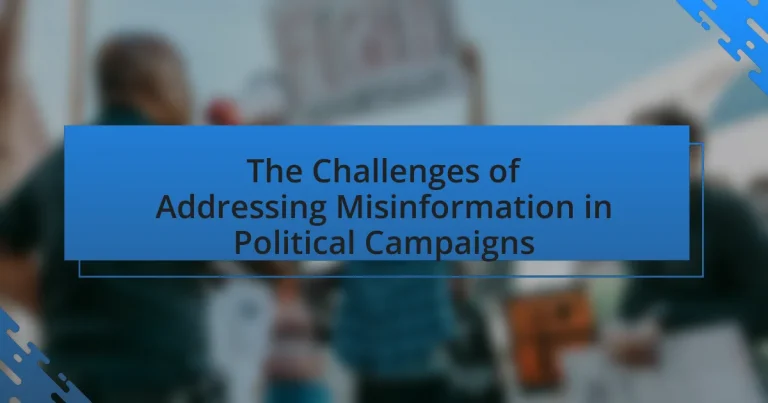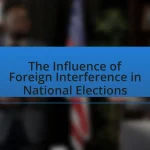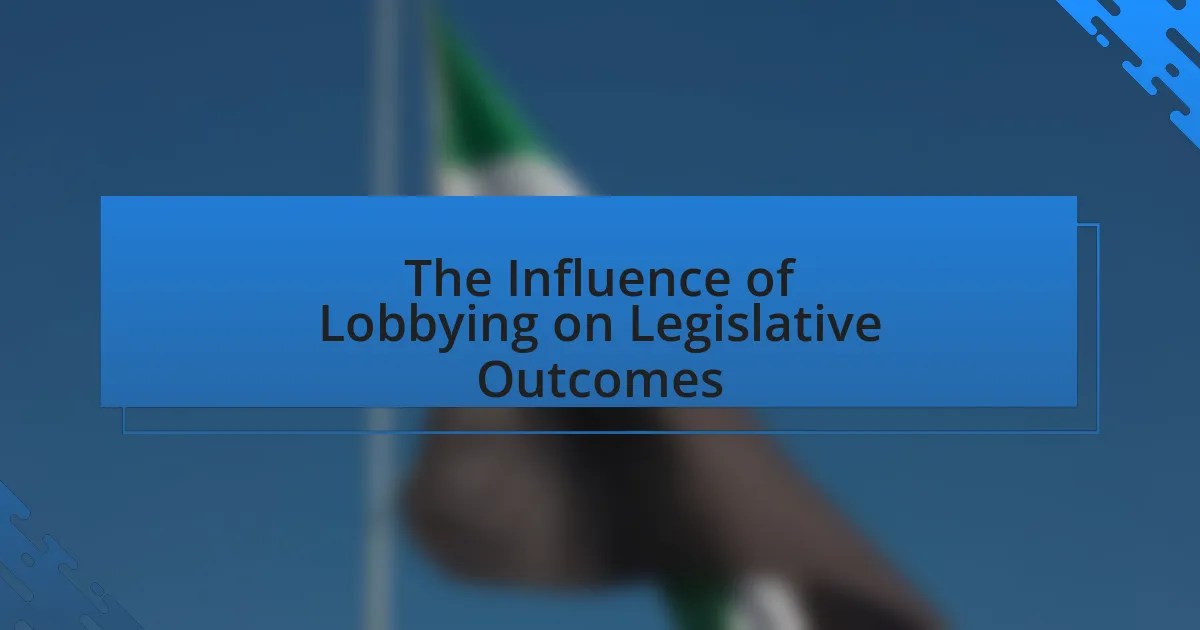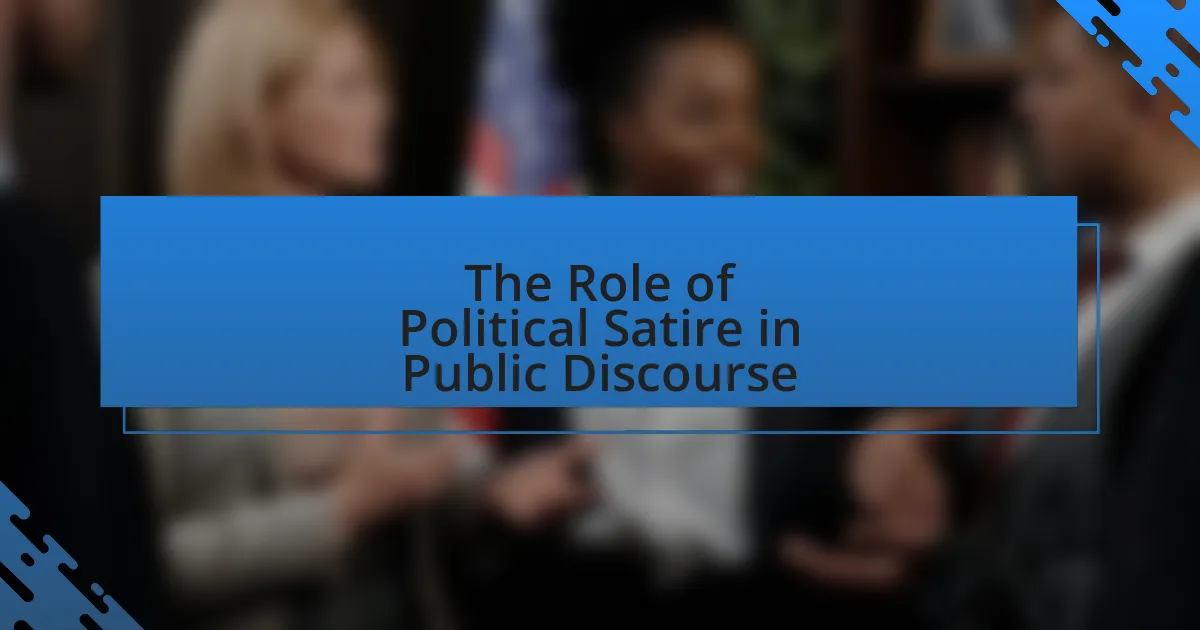The article examines the challenges of addressing misinformation in political campaigns, highlighting the rapid spread of false information, difficulties in identifying credible sources, and the emotional appeal of misleading narratives. It discusses the impact of misinformation on voter perception and behavior, including increased polarization and decreased trust in electoral processes. The article also explores psychological factors that contribute to the spread of misinformation, the role of social media platforms, and the legal complexities surrounding regulation. Additionally, it outlines strategies for combating misinformation, such as fact-checking, media literacy education, and proactive communication by political campaigns, while emphasizing the importance of transparency and collaboration in fostering an informed electorate.
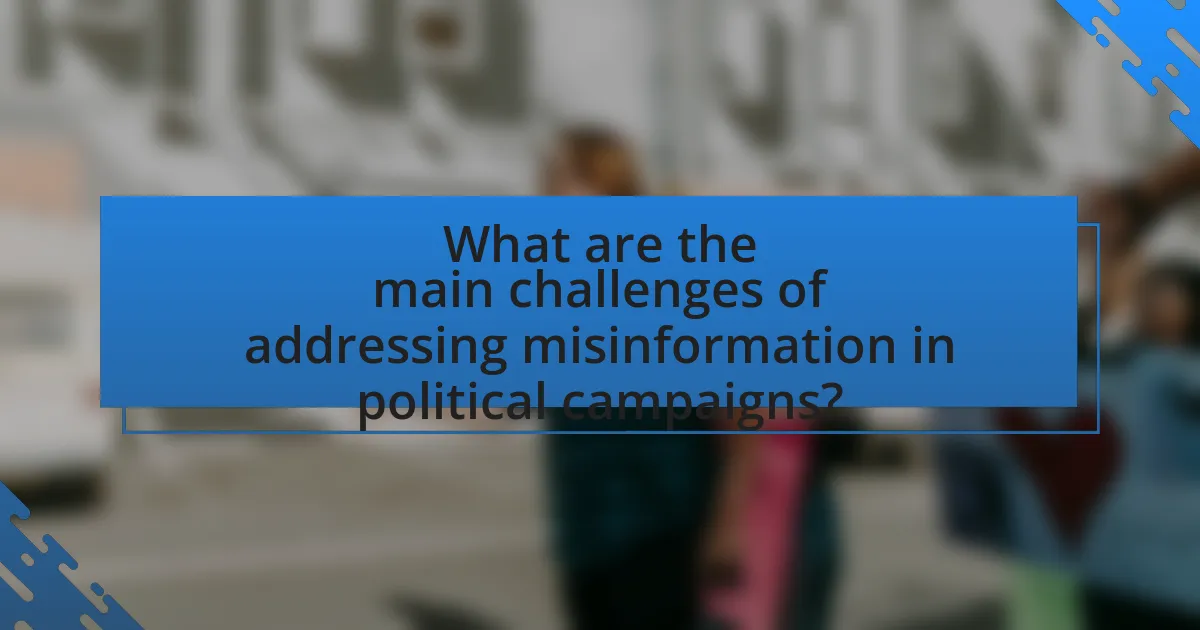
What are the main challenges of addressing misinformation in political campaigns?
The main challenges of addressing misinformation in political campaigns include the rapid spread of false information, the difficulty in identifying credible sources, and the emotional appeal of misleading narratives. Misinformation can spread quickly through social media platforms, making it hard for fact-checkers to keep up; for instance, a study by the Pew Research Center found that 64% of Americans believe that misinformation is a major problem in political discourse. Additionally, distinguishing between credible and non-credible sources is complicated, as many individuals may trust information from familiar or biased outlets. Lastly, emotionally charged misinformation often resonates more with audiences than factual content, leading to a preference for sensational narratives over accurate reporting.
How does misinformation impact voter perception and behavior?
Misinformation significantly distorts voter perception and behavior by shaping beliefs and attitudes based on false or misleading information. Research indicates that exposure to misinformation can lead to increased polarization, as voters may align more closely with their partisan identities when confronted with false narratives. For instance, a study published in the journal “Political Communication” found that misinformation can decrease trust in electoral processes and institutions, leading to lower voter turnout and engagement. Additionally, the Pew Research Center reported that 64% of Americans believe fabricated news stories cause confusion about the basic facts of current events, further illustrating how misinformation can manipulate public opinion and influence electoral outcomes.
What psychological factors contribute to the spread of misinformation?
Cognitive biases significantly contribute to the spread of misinformation. These biases, such as confirmation bias, lead individuals to favor information that aligns with their pre-existing beliefs while disregarding contradictory evidence. Research indicates that people are more likely to share misinformation that resonates with their views, as demonstrated in a study by Vosoughi, Roy, and Aral (2018) published in Science, which found that false news spreads more rapidly on social media than true news due to emotional engagement and cognitive shortcuts. Additionally, the Dunning-Kruger effect causes individuals with limited knowledge to overestimate their understanding, making them more susceptible to believing and disseminating false information. These psychological factors create an environment where misinformation can thrive, particularly in politically charged contexts.
How does misinformation influence public trust in political institutions?
Misinformation significantly undermines public trust in political institutions by creating confusion and skepticism about their integrity and effectiveness. When citizens encounter false or misleading information, they may question the motives and actions of political leaders, leading to a decline in perceived legitimacy. Research from the Pew Research Center indicates that 64% of Americans believe misinformation has a major impact on their trust in government. This erosion of trust can result in decreased civic engagement and increased polarization, as individuals gravitate towards sources that reinforce their beliefs, further entrenching misinformation’s damaging effects on democratic processes.
What role do social media platforms play in the dissemination of misinformation?
Social media platforms significantly contribute to the dissemination of misinformation by enabling rapid sharing and amplifying false narratives. These platforms facilitate the spread of misleading content through algorithms that prioritize engagement over accuracy, resulting in viral misinformation. For instance, a study published in the journal Science found that false news stories are 70% more likely to be retweeted than true stories, highlighting the platforms’ role in amplifying misleading information. Additionally, the lack of stringent content moderation policies allows unchecked misinformation to proliferate, further complicating efforts to address its impact on political campaigns.
How do algorithms contribute to the spread of false information?
Algorithms contribute to the spread of false information by prioritizing engagement over accuracy, leading to the amplification of sensational or misleading content. Social media platforms utilize algorithms that favor posts with high interaction rates, such as likes and shares, which often include false information because they evoke strong emotional responses. A study by the Massachusetts Institute of Technology found that false news stories are 70% more likely to be retweeted than true stories, highlighting how algorithmic design can inadvertently promote misinformation.
What measures are social media companies taking to combat misinformation?
Social media companies are implementing various measures to combat misinformation, including fact-checking partnerships, content moderation, and algorithm adjustments. For instance, platforms like Facebook and Twitter collaborate with independent fact-checkers to assess the accuracy of information shared on their sites, which helps to identify and label false content. Additionally, these companies employ artificial intelligence and human moderators to review and remove posts that violate community standards related to misinformation. According to a report by the Pew Research Center, 64% of Americans believe social media companies should take more responsibility for preventing the spread of false information, highlighting the public’s demand for effective measures.
Why is it difficult to regulate misinformation in political campaigns?
Regulating misinformation in political campaigns is difficult due to the rapid spread of information through digital platforms and the subjective nature of truth in political discourse. Digital platforms enable misinformation to circulate quickly, often outpacing fact-checking efforts. Additionally, political narratives can be framed in ways that resonate with specific audiences, making it challenging to establish a universal standard for what constitutes misinformation. The First Amendment in the United States further complicates regulation, as it protects free speech, including potentially false statements. Studies have shown that misinformation can influence voter behavior, as evidenced by research from the Pew Research Center, which found that 64% of Americans believe fabricated news stories cause confusion about the basic facts of current events.
What legal challenges arise when attempting to address misinformation?
Legal challenges that arise when attempting to address misinformation include issues related to freedom of speech, defamation laws, and the difficulty of defining misinformation. Freedom of speech protections, particularly in democratic societies, can limit the ability of governments and organizations to regulate or penalize the dissemination of false information. Defamation laws complicate the situation, as individuals or entities may be reluctant to take legal action against misinformation for fear of being accused of censorship or facing counterclaims. Additionally, the subjective nature of what constitutes misinformation creates challenges in establishing clear legal standards, as seen in cases where political statements are contested. These complexities highlight the tension between protecting free expression and ensuring accurate information dissemination in political contexts.
How do freedom of speech concerns complicate misinformation regulation?
Freedom of speech concerns complicate misinformation regulation by creating a tension between protecting individual expression and curbing harmful falsehoods. Legal frameworks, such as the First Amendment in the United States, prioritize free speech, making it challenging to implement regulations that could be perceived as censorship. For instance, attempts to regulate misinformation can lead to accusations of infringing on free speech rights, as seen in debates surrounding social media platforms’ content moderation policies. This complexity is underscored by the fact that misinformation can significantly impact democratic processes, yet any regulatory measures must carefully navigate the boundaries of free expression to avoid overreach or suppression of legitimate discourse.
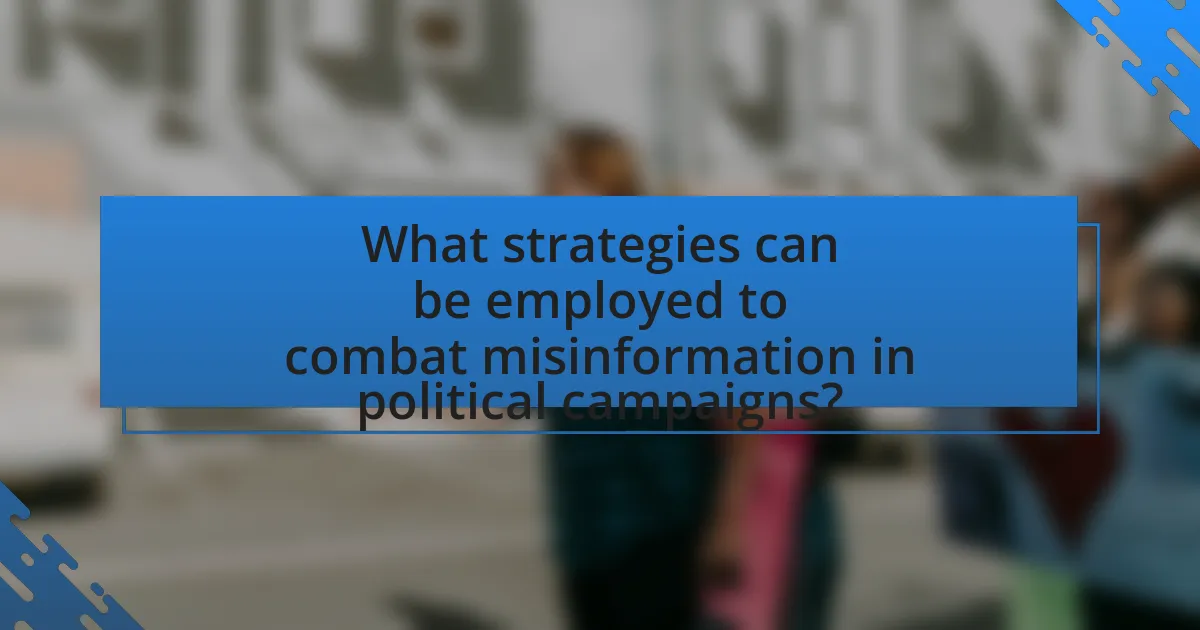
What strategies can be employed to combat misinformation in political campaigns?
To combat misinformation in political campaigns, strategies such as fact-checking, media literacy education, and the use of technology to identify false information can be employed. Fact-checking organizations, like PolitiFact and FactCheck.org, provide verified information that counters false claims, helping voters make informed decisions. Media literacy education equips individuals with critical thinking skills to assess the credibility of sources and recognize misinformation. Additionally, technology, including algorithms and artificial intelligence, can be utilized to detect and flag misleading content on social media platforms, as evidenced by initiatives from companies like Facebook and Twitter that aim to reduce the spread of false information. These strategies collectively enhance public awareness and promote a more informed electorate.
How can fact-checking organizations contribute to reducing misinformation?
Fact-checking organizations contribute to reducing misinformation by systematically verifying claims made in political discourse and providing accurate information to the public. These organizations analyze statements from politicians and media, often using a rigorous methodology that includes sourcing, evidence evaluation, and expert consultation. For instance, a study by the Pew Research Center found that 62% of Americans believe fact-checking helps them understand the truth behind political claims, indicating the effectiveness of these organizations in enhancing public awareness and critical thinking. By publishing their findings, fact-checking organizations not only correct falsehoods but also promote accountability among public figures, thereby fostering a more informed electorate.
What are the most effective methods used by fact-checkers?
The most effective methods used by fact-checkers include cross-referencing claims with reliable sources, utilizing automated fact-checking tools, and engaging in collaborative verification efforts. Cross-referencing involves comparing statements against credible databases, academic research, and official documents to confirm accuracy. Automated tools, such as natural language processing algorithms, help identify misinformation patterns and flag potentially false claims quickly. Collaborative verification involves partnerships among fact-checking organizations, journalists, and researchers to enhance the credibility and reach of fact-checking efforts, as demonstrated by initiatives like the International Fact-Checking Network, which promotes best practices and resource sharing among fact-checkers globally.
How can collaboration between media and fact-checkers enhance credibility?
Collaboration between media and fact-checkers enhances credibility by ensuring that information disseminated to the public is accurate and verified. This partnership allows media outlets to access expert analysis and data verification, which helps to reduce the spread of misinformation. For instance, studies have shown that news organizations that incorporate fact-checking into their reporting processes experience higher trust levels among audiences, as evidenced by a 2020 report from the Pew Research Center indicating that 62% of Americans believe fact-checking improves the reliability of news. By working together, media and fact-checkers can create a more informed public, ultimately strengthening the integrity of political discourse.
What role do educational initiatives play in addressing misinformation?
Educational initiatives play a crucial role in addressing misinformation by equipping individuals with critical thinking skills and media literacy. These initiatives help people discern credible information from falsehoods, thereby reducing the spread of misinformation. For instance, studies show that media literacy programs can significantly improve individuals’ ability to identify misleading content, with one research indicating a 50% increase in the ability to spot fake news among participants after completing such a program. By fostering an informed electorate, educational initiatives contribute to more transparent and accountable political discourse, ultimately mitigating the challenges posed by misinformation in political campaigns.
How can media literacy programs empower voters?
Media literacy programs empower voters by equipping them with critical thinking skills necessary to analyze and evaluate information sources effectively. These programs teach individuals how to discern credible news from misinformation, which is crucial in an era where political campaigns are often rife with false narratives. Research indicates that participants in media literacy initiatives demonstrate improved ability to identify biased or misleading content, thereby making more informed voting decisions. For instance, a study by the Stanford History Education Group found that students who received media literacy training were significantly better at evaluating the credibility of online information compared to those who did not receive such training. This enhanced capability directly contributes to a more informed electorate, ultimately strengthening democratic processes.
What are the best practices for educating the public about misinformation?
The best practices for educating the public about misinformation include promoting media literacy, encouraging critical thinking, and providing clear, factual information. Media literacy programs teach individuals how to analyze and evaluate sources, helping them discern credible information from falsehoods. Research by the Stanford History Education Group indicates that students who received media literacy training were better equipped to identify misinformation. Encouraging critical thinking involves teaching individuals to question the validity of information and consider multiple perspectives before forming conclusions. Additionally, providing clear, factual information through trusted channels, such as educational institutions and reputable organizations, reinforces accurate narratives and counters misinformation effectively.
How can political campaigns themselves address misinformation?
Political campaigns can address misinformation by implementing proactive communication strategies, fact-checking initiatives, and engaging with audiences through transparent messaging. Campaigns should establish dedicated teams to monitor misinformation and respond swiftly with accurate information. For instance, the 2020 U.S. presidential campaigns utilized social media platforms to counter false narratives by sharing verified facts and debunking myths in real-time. Research indicates that timely responses to misinformation can significantly reduce its spread; a study by the Pew Research Center found that 64% of Americans believe that social media companies should take stronger action against misinformation. By prioritizing transparency and accountability, political campaigns can effectively mitigate the impact of misinformation on their electoral processes.
What proactive measures can candidates take to ensure accurate information dissemination?
Candidates can ensure accurate information dissemination by implementing a comprehensive communication strategy that includes fact-checking, transparency, and engaging with credible sources. By establishing a dedicated team to verify information before it is shared, candidates can significantly reduce the risk of spreading misinformation. For instance, a study by the Pew Research Center found that 64% of Americans believe that fact-checking is essential for political communication, highlighting the importance of accuracy in messaging. Additionally, candidates should actively engage with reputable media outlets and utilize social media platforms to clarify their positions and correct any inaccuracies promptly. This proactive approach not only builds trust with the electorate but also fosters a more informed public discourse.
How can transparency in campaign messaging build trust with voters?
Transparency in campaign messaging builds trust with voters by providing clear, honest, and accessible information about candidates’ policies and intentions. When voters receive straightforward communication, they are more likely to feel informed and empowered, which fosters a sense of reliability in the candidate. Research indicates that 70% of voters prefer candidates who are open about their positions and past actions, as this openness reduces skepticism and enhances credibility. Furthermore, transparency helps to counter misinformation by allowing voters to verify claims independently, thereby reinforcing trust in the electoral process.
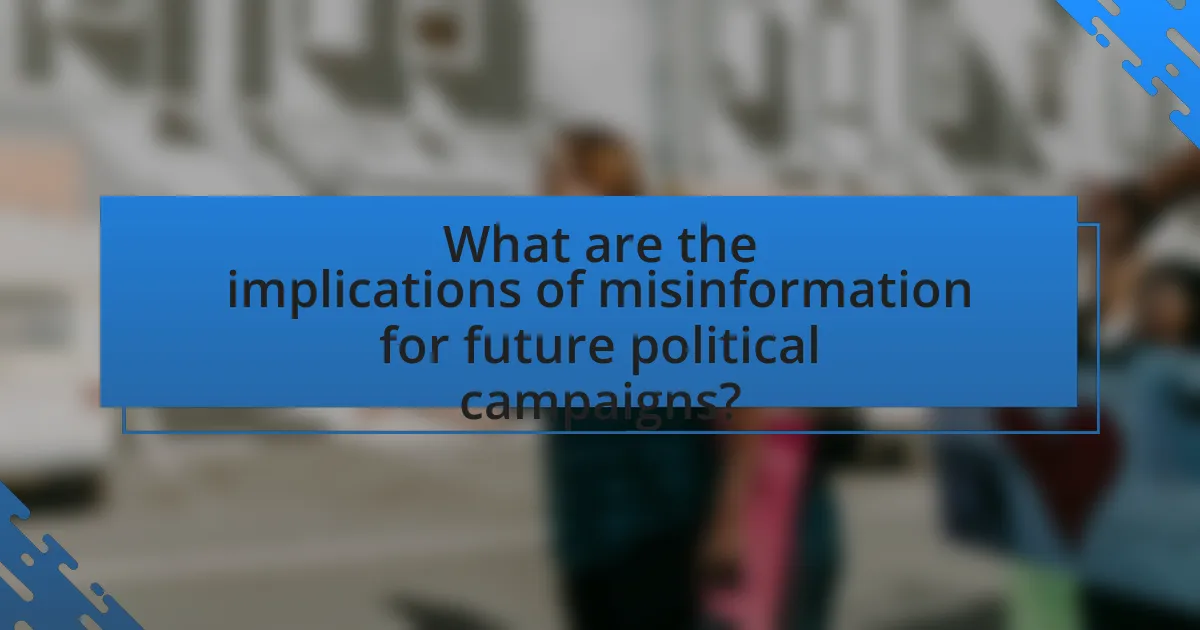
What are the implications of misinformation for future political campaigns?
Misinformation significantly undermines the integrity of future political campaigns by distorting public perception and influencing voter behavior. This distortion can lead to the spread of false narratives, which may sway undecided voters and reinforce biases among supporters. For instance, a study by the Pew Research Center found that 64% of Americans believe fabricated news stories cause confusion about the basic facts of current events, indicating a widespread impact on public understanding. Furthermore, misinformation can erode trust in democratic institutions, as voters may become skeptical of legitimate information sources, leading to increased polarization and disengagement from the political process.
How might misinformation evolve in future elections?
Misinformation in future elections may evolve through increased use of advanced technologies, such as artificial intelligence and deepfakes, which can create highly convincing but false narratives. As seen in the 2020 U.S. elections, social media platforms became significant vectors for misinformation, and this trend is likely to continue as algorithms become more sophisticated in targeting specific demographics with tailored false information. Research indicates that misinformation spreads faster and more widely than factual information, as demonstrated by a 2018 study published in Science, which found that false news stories are 70% more likely to be retweeted than true stories. This suggests that future elections will face challenges not only from the volume of misinformation but also from its increasing sophistication and ability to manipulate public perception effectively.
What technological advancements could influence the spread of misinformation?
Technological advancements such as artificial intelligence, social media algorithms, and deepfake technology significantly influence the spread of misinformation. Artificial intelligence enables the rapid generation and dissemination of false narratives, while social media algorithms prioritize engagement over accuracy, amplifying misleading content. Deepfake technology allows for the creation of realistic but fabricated videos, further blurring the line between truth and deception. For instance, a study by MIT found that false news spreads six times faster than true news on social media platforms, highlighting the impact of these technologies on misinformation proliferation.
How can political campaigns prepare for emerging misinformation tactics?
Political campaigns can prepare for emerging misinformation tactics by implementing proactive monitoring and rapid response strategies. Establishing a dedicated team to track misinformation across social media platforms allows campaigns to identify false narratives quickly. Research indicates that campaigns that engage in real-time fact-checking and transparent communication can mitigate the impact of misinformation, as seen in the 2020 U.S. elections where timely responses helped counteract misleading claims. Additionally, educating supporters about misinformation tactics fosters a more informed base that can recognize and challenge false information effectively.
What lessons can be learned from past political campaigns regarding misinformation?
Past political campaigns reveal that proactive fact-checking and transparency are essential in combating misinformation. For instance, during the 2016 U.S. presidential election, the proliferation of false information on social media significantly influenced public perception and voter behavior. Research by the Pew Research Center indicated that 64% of Americans believed fabricated news stories caused confusion about the basic facts of current events. This underscores the necessity for campaigns to establish clear communication channels and engage in real-time fact-checking to counter misinformation effectively. Additionally, the 2020 election demonstrated the importance of collaboration with social media platforms to flag or remove misleading content, highlighting that partnerships can enhance the credibility of information shared during campaigns.
What case studies illustrate successful responses to misinformation?
Case studies illustrating successful responses to misinformation include the 2016 U.S. presidential election efforts by the fact-checking organization PolitiFact and the 2020 COVID-19 pandemic response by the World Health Organization (WHO). PolitiFact effectively countered false claims by providing real-time fact-checking and promoting transparency, which helped inform voters and reduce the spread of misinformation. During the COVID-19 pandemic, WHO launched the “Mythbusters” campaign, which addressed common misconceptions about the virus through clear, evidence-based information, significantly improving public understanding and trust. These examples demonstrate effective strategies in combating misinformation through timely, accurate communication and public engagement.
How can historical patterns of misinformation inform future strategies?
Historical patterns of misinformation can inform future strategies by highlighting the tactics and channels that have been most effective in spreading false information. For instance, the 2016 U.S. presidential election demonstrated that social media platforms were pivotal in disseminating misleading narratives, as evidenced by the proliferation of fake news articles that reached millions of users. Analyzing these patterns allows strategists to identify vulnerabilities in communication channels and develop targeted countermeasures, such as enhancing media literacy programs and implementing stricter regulations on social media content. Furthermore, studies indicate that misinformation often exploits emotional triggers, suggesting that future strategies should focus on promoting factual content that resonates emotionally with audiences to counteract misleading narratives effectively.
What practical steps can individuals take to combat misinformation in political campaigns?
Individuals can combat misinformation in political campaigns by critically evaluating sources of information before sharing or believing them. This involves verifying facts through reputable news outlets, fact-checking websites, and official statements from credible organizations. Research indicates that misinformation spreads rapidly on social media, with a study from MIT showing that false news stories are 70% more likely to be retweeted than true stories. By cross-referencing information and relying on established sources, individuals can reduce the likelihood of spreading false narratives. Additionally, engaging in discussions that promote media literacy can empower others to recognize and challenge misinformation effectively.
